Dexmethylphenidate
Editor-In-Chief: C. Michael Gibson, M.S., M.D. [1]; Associate Editor(s)-in-Chief: Kiran Singh, M.D. [2]
Disclaimer
WikiDoc MAKES NO GUARANTEE OF VALIDITY. WikiDoc is not a professional health care provider, nor is it a suitable replacement for a licensed healthcare provider. WikiDoc is intended to be an educational tool, not a tool for any form of healthcare delivery. The educational content on WikiDoc drug pages is based upon the FDA package insert, National Library of Medicine content and practice guidelines / consensus statements. WikiDoc does not promote the administration of any medication or device that is not consistent with its labeling. Please read our full disclaimer here.
Black Box Warning
|
DRUG DEPENDENCE:
See full prescribing information for complete Boxed Warning.
Dexmethylphenidate hydrochloride tablets should be given cautiously to patients with a history of drug dependence or alcoholism. Chronic, abusive use can lead to marked tolerance and psychological dependence with varying degrees of abnormal behavior. Frank psychotic episodes can occur, especially with parenteral abuse. Careful supervision is required during drug withdrawal from abusive use since severe depression may occur. Withdrawal following chronic therapeutic use may unmask symptoms of the underlying disorder that may require follow-up.
|
Overview
Dexmethylphenidate is a Psycostimulant that is FDA approved for the treatment of ADHD. There is a Black Box Warning for this drug as shown here. Common adverse reactions include dyspepsia, decreased appetite, headache,anxiety.
Adult Indications and Dosage
FDA-Labeled Indications and Dosage (Adult)
- Dexmethylphenidate hydrochloride tablets are indicated for the treatment of Attention Deficit Hyperactivity Disorder (ADHD).
Dosing Information
- Dosage should be individualized according to the needs and responses of the patient.
Patients New to Methylphenidate
- The recommended starting dose of dexmethylphenidate hydrochloride tablets for patients who are not currently taking racemic methylphenidate, or for patients who are on stimulants other than methylphenidate, is 5 mg/day (2.5 mg twice daily).
- Dosage may be adjusted in 2.5 to 5 mg increments to a maximum of 20 mg/day (10 mg twice daily). In general, dosage adjustments may proceed at approximately weekly intervals.
Patients Currently Using Methylphenidate
- For patients currently using methylphenidate, the recommended starting dose of dexmethylphenidate hydrochloride tablets is half the dose of racemic methylphenidate. The maximum recommended dose is 20 mg/day (10 mg twice daily).
Dose Reduction and Discontinuation
- If paradoxical aggravation of symptoms or other adverse events occur, the dosage should be reduced, or, if necessary, the drug should be discontinued.
- If improvement is not observed after appropriate dosage adjustment over a 1 month period, the drug should be discontinued.
Off-Label Use and Dosage (Adult)
Guideline-Supported Use
- There is limited information regarding Off-Label Guideline-Supported Use of Dexmethylphenidate in adult patients.
Non–Guideline-Supported Use
- There is limited information regarding Off-Label Non–Guideline-Supported Use of Dexmethylphenidate in adult patients.
Pediatric Indications and Dosage
FDA-Labeled Indications and Dosage (Pediatric)
- The safety and efficacy of dexmethylphenidate hydrochloride in children under 6 years old have not been established. Long-term effects of dexmethylphenidate hydrochloride in children have not been well established.
Off-Label Use and Dosage (Pediatric)
Guideline-Supported Use
- There is limited information regarding Off-Label Guideline-Supported Use of Dexmethylphenidate in pediatric patients.
Non–Guideline-Supported Use
- There is limited information regarding Off-Label Non–Guideline-Supported Use of Dexmethylphenidate in pediatric patients.
Contraindications
Agitation
- Dexmethylphenidate hydrochloride tablets are contraindicated in patients with marked anxiety, tension, and agitation, since the drug may aggravate these symptoms.
Hypersensitivity to Methylphenidate
- Dexmethylphenidate hydrochloride tablets are contraindicated in patients known to be hypersensitive to methylphenidate or other components of the product. Hypersensitivity reactions, including angioedema and anaphylactic reactions, have been observed in patients treated with methylphenidate.
Glaucoma
- Dexmethylphenidate hydrochloride tablets are contraindicated in patients with glaucoma.
Tics
- Dexmethylphenidate hydrochloride tablets are contraindicated in patients with motor tics or with a family history or diagnosis of Tourette’s syndrome.
Monoamine Oxidase Inhibitors
- Dexmethylphenidate hydrochloride tablets are contraindicated during treatment with monoamine oxidase inhibitors, and also within a minimum of 14 days following discontinuation of a monoamine oxidase inhibitor (hypertensive crises may result).
Warnings
|
DRUG DEPENDENCE:
See full prescribing information for complete Boxed Warning.
Dexmethylphenidate hydrochloride tablets should be given cautiously to patients with a history of drug dependence or alcoholism. Chronic, abusive use can lead to marked tolerance and psychological dependence with varying degrees of abnormal behavior. Frank psychotic episodes can occur, especially with parenteral abuse. Careful supervision is required during drug withdrawal from abusive use since severe depression may occur. Withdrawal following chronic therapeutic use may unmask symptoms of the underlying disorder that may require follow-up.
|
Serious Cardiovascular Events
- Sudden Death and Preexisting Structural Cardiac Abnormalities or Other Serious Heart Problems
Children and adolescents
- Sudden death has been reported in association with CNS stimulant treatment at usual doses in children and adolescents with structural cardiac abnormalities or other serious heart problems. Although some serious heart problems alone carry an increased risk of sudden death, stimulant products generally should not be used in children or adolescents with known serious structural cardiac abnormalities, cardiomyopathy, serious heart rhythm abnormalities, or other serious cardiac problems that may place them at increased vulnerability to the sympathomimetic effects of a stimulant drug.
Adults
- Sudden death, stroke, and myocardial infarction have been reported in adults taking stimulant drugs at usual doses for ADHD. Although the role of stimulants in these adult cases is also unknown, adults have a greater likelihood than children of having serious structural cardiac abnormalities, cardiomyopathy, serious heart rhythm abnormalities, coronary artery disease, or other serious cardiac problems. Adults with such abnormalities should also generally not be treated with stimulant drugs.
Hypertension and Other Cardiovascular Conditions
- Stimulant medications cause a modest increase in average blood pressure (about 2 to 4 mmHg) and average heart rate (about 3 to 6 bpm), and individuals may have larger increases. While the mean changes alone would not be expected to have short-term consequences, all patients should be monitored for larger changes in heart rate and blood pressure. Caution is indicated in treating patients whose underlying medical conditions might be compromised by increases in blood pressure or heart rate, e.g., those with preexisting hypertension, heart failure, recent myocardial infarction, or ventricular arrhythmia.
Assessing Cardiovascular Status in Patients Being Treated With Stimulant Medications
- Children, adolescents, or adults who are being considered for treatment with stimulant medications should have a careful history (including assessment for a family history of sudden death or ventricular arrhythmia) and physical exam to assess for the presence of cardiac disease, and should receive further cardiac evaluation if findings suggest such disease (e.g., electrocardiogram and echocardiogram). Patients who develop symptoms such as exertional chest pain, unexplained syncope, or other symptoms suggestive of cardiac disease during stimulant treatment should undergo a prompt cardiac evaluation.
Psychiatric Adverse Events
Preexisting Psychosis
- Administration of stimulants may exacerbate symptoms of behavior disturbance and thought disorder in patients with a preexisting psychotic disorder.
Bipolar Illness
- Particular care should be taken in using stimulants to treat ADHD in patients with comorbid bipolar disorder because of concern for possible induction of a mixed/manic episode in such patients. Prior to initiating treatment with a stimulant, patients with comorbid depressive symptoms should be adequately screened to determine if they are at risk for bipolar disorder; such screening should include a detailed psychiatric history, including a family history of suicide, bipolar disorder, and depression.
Emergence of New Psychotic or Manic Symptoms
- Treatment emergent psychotic or manic symptoms, e.g., hallucinations, delusional thinking, or mania in children and adolescents without a prior history of psychotic illness or mania can be caused by stimulants at usual doses. If such symptoms occur, consideration should be given to a possible causal role of the stimulant, and discontinuation of treatment may be appropriate. In a pooled analysis of multiple short-term, placebo-controlled studies, such symptoms occurred in about 0.1% (4 patients with events out of 3,482 exposed to methylphenidate or amphetamine for several weeks at usual doses) of stimulant-treated patients compared to 0 in placebo-treated patients.
Aggression
- Aggressive behavior or hostility is often observed in children and adolescents with ADHD, and has been reported in clinical trials and the postmarketing experience of some medications indicated for the treatment of ADHD. Although there is no systematic evidence that stimulants cause aggressive behavior or hostility, patients beginning treatment for ADHD should be monitored for the appearance of or worsening of aggressive behavior or hostility.
Long-Term Suppression of Growth
- Careful follow-up of weight and height in children ages 7 to 10 years who were randomized to either methylphenidate or non-medication treatment groups over 14 months, as well as in naturalistic subgroups of newly methylphenidate-treated and non-medication treated children over 36 months (to the ages of 10 to 13 years), suggests that consistently medicated children (i.e., treatment for 7 days per week throughout the year) have a temporary slowing in growth rate (on average, a total of about 2 cm less growth in height and 2.7 kg less growth in weight over 3 years), without evidence of growth rebound during this period of development. Published data are inadequate to determine whether chronic use of amphetamines may cause a similar suppression of growth, however, it is anticipated that they likely have this effect as well. Therefore, growth should be monitored during treatment with stimulants, and patients who are not growing or gaining height or weight as expected may need to have their treatment interrupted.
Seizures
- There is some clinical evidence that stimulants may lower the convulsive threshold in patients with prior history of seizures, in patients with prior EEG abnormalities in absence of seizures, and, very rarely, in patients without a history of seizures and no prior EEG evidence of seizures. In the presence of seizures, the drug should be discontinued.
Priapism
- Prolonged and painful erections, sometimes requiring surgical intervention, have been reported with methylphenidate products in both pediatric and adult patients. Priapism was not reported with drug initiation but developed after some time on the drug, often subsequent to an increase in dose. Priapism has also appeared during a period of drug withdrawal (drug holidays or discontinuation). Patients who develop abnormally sustained or frequent and painful erections should seek immediate medical attention.
Peripheral Vasculopathy, including Raynaud’s phenomenon
- Stimulants, including dexmethylphenidate hydrochloride tablets, used to treat ADHD are associated with peripheral vasculopathy, including Raynaud’s phenomenon. Signs and symptoms are usually intermittent and mild; however, very rare sequelae include digital ulceration and/or soft tissue breakdown. Effects of peripheral vasculopathy, including Raynaud’s phenomenon, were observed in postmarketing reports at different times and at therapeutic doses in all age groups throughout the course of treatment. Signs and symptoms generally improve after reduction in dose or discontinuation of drug. Careful observation for digital changes is necessary during treating with ADHD stimulants. Further clinical evaluation (e.g., rheumatology referral) may be appropriate for certain patients.
PRECAUTIONS
Hematologic Monitoring
- Periodic CBC, differential, and platelet counts are advised during prolonged therapy.
Information for Patients
- Prescribers or other health professionals should inform patients, their families, and their caregivers about the benefits and risks associated with treatment with dexmethylphenidate and should counsel them in its appropriate use. A patient Medication Guide is available for dexmethylphenidate hydrochloride tablets. The prescriber or health professional should instruct patients, their families, and their caregivers to read the Medication Guide and should assist them in understanding its contents. Patients should be given the opportunity to discuss the contents of the Medication Guide and to obtain answers to any questions they may have.
Priapism
- Advise patients, caregivers, and family members of the possibility of painful or prolonged penile erections (priapism). Instruct the patient to seek immediate medical attention in the event of priapism.
- Circulation problems in fingers and toes [Peripheral vasculopathy, including Raynaud’s phenomenon]
- Instruct patients beginning treatment with dexmethylphenidate hydrochloride tablets about the risk of peripheral vasculopathy, including Raynaud’s Phenomenon, and associated signs and symptoms: fingers or toes may feel numb, cool, painful, and/or may change color from pale, to blue, to red.
- Instruct patients to report to their physician any new numbness, pain, skin color change, or sensitivity to temperature in fingers or toes.
- Instruct patients to call their physician immediately with any signs of unexplained wounds appearing on fingers or toes while taking dexmethylphenidate hydrochloride tablets.
- Further clinical evaluation (e.g., rheumatology referral) may be appropriate for certain patients.
Adverse Reactions
Clinical Trials Experience
Adverse Events Associated With Discontinuation of Treatment
- No dexmethylphenidate hydrochloride-treated patients discontinued due to adverse events in two placebo-controlled trials. Overall, 50 of 684 children treated with dexmethylphenidate hydrochloride (7.3%) experienced an adverse event that resulted in discontinuation. The most common reasons for discontinuation were twitching (described as motor or vocal tics), anorexia, insomnia, and tachycardia (approximately 1% each).
Adverse Events Occurring at an Incidence of 5% or More Among Dexmethylphenidate Hydrochloride-Treated Patients
- Table 1 enumerates treatment-emergent adverse events for two, placebo-controlled, parallel group trials in children with ADHD at dexmethylphenidate hydrochloride doses of 5, 10, and 20 mg/day. The table includes only those events that occurred in 5% or more of patients treated with dexmethylphenidate hydrochloride where the incidence in patients treated with dexmethylphenidate hydrochloride was at least twice the incidence in placebo-treated patients. The prescriber should be aware that these figures cannot be used to predict the incidence of adverse events in the course of usual medical practice where patient characteristics and other factors differ from those which prevailed in the clinical trials. Similarly, the cited frequencies cannot be compared with figures obtained from other clinical investigations involving different treatments, uses, and investigators. The cited figures, however, do provide the prescribing physician with some basis for estimating the relative contribution of drug and non-drug factors to the adverse event incidence rate in the population studied.

Postmarketing Experience
- The following additional adverse reactions have been identified during postapproval use of dexmethylphenidate hydrochloride extended-release tablets. Because these reactions are reported voluntarily from a population of uncertain size, it is not always possible to reliably estimate their frequency:
Immune System Disorders
- Hypersensitivity reactions, including angioedema and anaphylaxis.
Adverse Events with Other Methylphenidate HCl Products
- Nervousness and insomnia are the most common adverse reactions reported with other methylphenidate products. In children, loss of appetite, abdominal pain, weight loss during prolonged therapy, insomnia, and tachycardia may occur more frequently; however, any of the other adverse reactions listed below may also occur.
Other Reactions Include
Cardiac
Angina, arrhythmia, palpitations, pulse increased or decreased, tachycardia
Gastrointestinal
- Nausea
Immune
- Hypersensitivity reactions including skin rash, urticaria, fever, arthralgia, exfoliative dermatitis, erythema multiforme with histopathological findings of necrotizing vasculitis, and thrombocytopenic purpura
Nervous System
- Dizziness, drowsiness, dyskinesia, headache, rare reports of Tourette’s syndrome, toxic psychosis
Vascular
- Blood pressure increased or decreased, cerebral arteritis and/or occlusion
Although a definite causal relationship has not been established, the following have been reported in patients taking methylphenidate:
Blood/lymphatic
- Leukopenia and/or anemia
Hepatobiliary
- Abnormal liver function, ranging from transaminase elevation to hepatic coma
Psychiatric
- Transient depressed mood, aggressive behavior, libido changes
Skin/subcutaneous
- scalp hair loss
Urogenital
- Priapism
Very rare reports of neuroleptic malignant syndrome (NMS) have been received, and, in most of these, patients were concurrently receiving therapies associated with NMS. In a single report, a ten year old boy who had been taking methylphenidate for approximately 18 months experienced an NMS-like event within 45 minutes of ingesting his first dose of venlafaxine. It is uncertain whether this case represented a drug-drug interaction, a response to either drug alone, or some other cause. In children, loss of appetite, abdominal pain, weight loss during prolonged therapy, insomnia, and tachycardia may occur more frequently; however, any of the other adverse reactions listed above may also occur.
Drug Interactions
- Methylphenidate may decrease the effectiveness of drugs used to treat hypertension. Because of possible effects on blood pressure, dexmethylphenidate hydrochloride should be used cautiously with pressor agents.
- Human pharmacologic studies have shown that racemic methylphenidate may inhibit the metabolism of coumarin anticoagulants, anticonvulsants (e.g., phenobarbital, phenytoin, primidone), and some antidepressants (tricyclics and selective serotonin reuptake inhibitors). Downward dose adjustments of these drugs may be required when given concomitantly with methylphenidate. It may be necessary to adjust the dosage and monitor plasma drug concentration (or, in the case of coumarin, coagulation times), when initiating or discontinuing concomitant methylphenidate.
Use in Specific Populations
Pregnancy
Teratogenic Effects
Pregnancy category C
- In studies conducted in rats and rabbits, dexmethylphenidate was administered orally at doses of up to 20 and 100 mg/kg/day, respectively, during the period of organogenesis. No evidence of teratogenic activity was found in either the rat or rabbit study; however, delayed fetal skeletal ossification was observed at the highest dose level in rats. When dexmethylphenidate was administered to rats throughout pregnancy and lactation at doses of up to 20 mg/kg/day, postweaning body weight gain was decreased in male offspring at the highest dose, but no other effects on postnatal development were observed. At the highest doses tested, plasma levels (AUCs) of dexmethylphenidate in pregnant rats and rabbits were approximately 5 and 1 times, respectively, those in adults dosed with the maximum recommended human dose of 20 mg/day.
- Racemic methylphenidate has been shown to have teratogenic effects in rabbits when given in doses of 200 mg/kg/day throughout organogenesis.
- Adequate and well-controlled studies in pregnant women have not been conducted. Dexmethylphenidate hydrochloride should be used during pregnancy only if the potential benefit justifies the potential risk to the fetus.
- There is no Australian Drug Evaluation Committee (ADEC) guidance on usage of Dexmethylphenidate in women who are pregnant.
Labor and Delivery
- There is no FDA guidance on use of Dexmethylphenidate during labor and delivery.
Nursing Mothers
- It is not known whether dexmethylphenidate is excreted in human milk. Because many drugs are excreted in human milk, caution should be exercised if dexmethylphenidate hydrochloride is administered to a nursing woman.*
Pediatric Use
- The safety and efficacy of dexmethylphenidate hydrochloride in children under 6 years old have not been established. Long-term effects of dexmethylphenidate hydrochloride in children have not been well established.
- In a study conducted in young rats, racemic methylphenidate was administered orally at doses of up to 100 mg/kg/day for 9 weeks, starting early in the postnatal period (Postnatal Day 7) and continuing through sexual maturity (Postnatal Week 10). When these animals were tested as adults (Postnatal Weeks 13 to 14), decreased spontaneous locomotor activity was observed in males and females previously treated with 50 mg/kg/day (approximately 6 times the maximum recommended human dose [MRHD] of racemic methylphenidate on a mg/m2 basis) or greater, and a deficit in the acquisition of a specific learning task was seen in females exposed to the highest dose (12 times the racemic MRHD on a mg/m2 basis). The no effect level for juvenile neurobehavioral development in rats was 5 mg/kg/day (half the racemic MRHD on a mg/m2 basis). The clinical significance of the long-term behavioral effects observed in rats is unknown.
Geriatic Use
- There is no FDA guidance on the use of Dexmethylphenidate with respect to geriatric patients.
Gender
- Pharmacokinetic parameters were similar for boys and girls (mean age 10 years).
- In a single dose study conducted in adults, the mean dexmethylphenidate AUC0-inf values (adjusted for body weight) following single 2 x 10 mg doses of dexmethylphenidate hydrochloride were 25% to 35% higher in adult female volunteers (n = 6) compared to male volunteers (n = 9). Both tmax and t1/2 were comparable for males and females.
Race
- There is insufficient experience with the use of dexmethylphenidate hydrochloride to detect ethnic variations in pharmacokinetics.
Renal Impairment
- There is no experience with the use of dexmethylphenidate hydrochloride in patients with renal insufficiency. After oral administration of radiolabeled racemic methylphenidate in humans, methylphenidate was extensively metabolized and approximately 80% of the radioactivity was excreted in the urine in the form of ritalinic acid. Since very little unchanged drug is excreted in the urine, renal insufficiency is expected to have little effect on the pharmacokinetics of dexmethylphenidate hydrochloride.
Hepatic Impairment
- There is no experience with the use of dexmethylphenidate hydrochloride in patients with hepatic insufficiency.
Females of Reproductive Potential and Males
- There is no FDA guidance on the use of Dexmethylphenidate in women of reproductive potentials and males.
Immunocompromised Patients
- There is no FDA guidance one the use of Dexmethylphenidate in patients who are immunocompromised.
Administration and Monitoring
Administration
- Route of Administration
- ORAL
- Dexmethylphenidate hydrochloride tablets are administered twice daily, at least 4 hours apart. Dexmethylphenidate hydrochloride tablets may be administered with or without food.
Monitoring
Hematologic Monitoring
Periodic CBC, differential, and platelet counts are advised during prolonged therapy.
IV Compatibility
- There is limited information regarding IV Compatibility of Dexmethylphenidate in the drug label.
Overdosage
Signs and Symptoms
- Signs and symptoms of acute methylphenidate overdosage, resulting principally from overstimulation of the CNS and from excessive sympathomimetic effects, may include the following: vomiting, agitation, tremors, hyperreflexia, muscle twitching, convulsions (may be followed by coma), euphoria, confusion, hallucinations, delirium, sweating, flushing, headache, hyperpyrexia, tachycardia, palpitations, cardiac arrhythmias, hypertension, mydriasis, and dryness of mucous membranes.
Recommended Treatment
- Treatment consists of appropriate supportive measures. The patient must be protected against self-injury and against external stimuli that would aggravate overstimulation already present. Gastric contents may be evacuated by gastric lavage as indicated. Before performing gastric lavage, control agitation and seizures if present and protect the airway. Other measures to detoxify the gut include administration of activated charcoal and a cathartic. Intensive care must be provided to maintain adequate circulation and respiratory exchange; external cooling procedures may be required for hyperpyrexia.
- Efficacy of peritoneal dialysis for dexmethylphenidate hydrochloride overdosage has not been established.
Poison Control Center
- As with the management of all overdosage, the possibility of multiple drug ingestion should be considered. The physician may wish to consider contacting a poison control center for up-to-date information on the management of overdosage with methylphenidate.
Pharmacology

| |
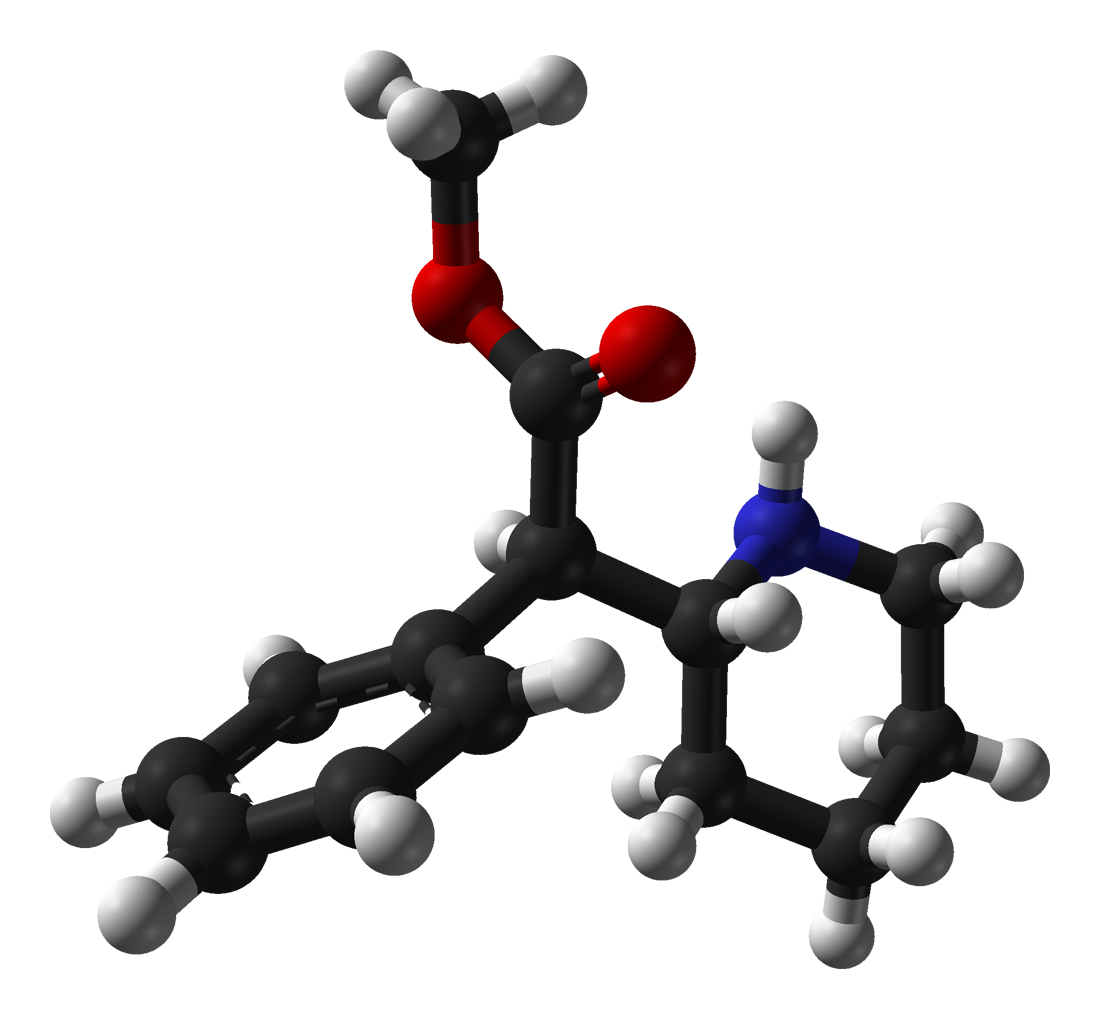
| |
Dexmethylphenidate
| |
| Systematic (IUPAC) name | |
| (R,R)-(+)-Methyl 2-phenyl-2-(2-piperidyl)acetate | |
| Identifiers | |
| CAS number | |
| ATC code | N06 |
| PubChem | |
| DrugBank | |
| Chemical data | |
| Formula | Template:OrganicBox atomTemplate:OrganicBox atomTemplate:OrganicBoxTemplate:OrganicBoxTemplate:OrganicBoxTemplate:OrganicBoxTemplate:OrganicBoxTemplate:OrganicBoxTemplate:OrganicBoxTemplate:OrganicBoxTemplate:OrganicBoxTemplate:OrganicBoxTemplate:OrganicBoxTemplate:OrganicBox atomTemplate:OrganicBoxTemplate:OrganicBox atomTemplate:OrganicBoxTemplate:OrganicBoxTemplate:OrganicBoxTemplate:OrganicBoxTemplate:OrganicBoxTemplate:OrganicBoxTemplate:OrganicBox |
| Mol. mass | 233.31 g/mol |
| SMILES | & |
| Pharmacokinetic data | |
| Bioavailability | 11 – 52% |
| Protein binding | 30% |
| Metabolism | hepatic |
| Half life | 4 hours |
| Excretion | renal |
| Therapeutic considerations | |
| Pregnancy cat. |
C |
| Legal status |
Controlled (S8)(AU) Schedule III(CA) Class B(UK) Schedule II(US) |
| Routes | oral |
Mechanism of Action
There is limited information regarding Mechanism of Action of Dexmethylphenidate in the drug label.
Structure
- Dexmethylphenidate hydrochloride is the d-threo-enantiomer of racemic methylphenidate hydrochloride, which is a 50/50 mixture of the d-threo and l-threo-enantiomers. Dexmethylphenidate hydrochloride is a central nervous system (CNS) stimulant, available in three tablet strengths. Each tablet contains dexmethylphenidate hydrochloride 2.5, 5, or 10 mg for oral administration. Dexmethylphenidate hydrochloride is methyl α-phenyl-2-piperidineacetate hydrochloride, (R,R’)-(+)-. Its structural formula is:
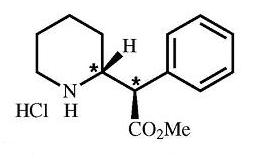
- C14H19NO2•HCl M.W. 269.77
- Note: * = asymmetric carbon centers
- Dexmethylphenidate hydrochloride is a white to off-white powder. Its solutions are acid to litmus. It is freely soluble in water and in methanol, soluble in alcohol, and slightly soluble in chloroform and in acetone.
- Dexmethylphenidate hydrochloride tablets also contain the following inert ingredients: lactose anhydrous, lactose monohydrate, magnesium stearate, microcrystalline cellulose, pregelatinized starch, and sodium starch glycolate. Additionally, 5 mg tablets contain D&C Yellow #10 aluminum lake; 2.5 mg tablets contain FD&C Blue #2 lake; 5 mg and 10 mg tablets contain colloidal silicon dioxide.
Pharmacodynamics
Dexmethylphenidate hydrochloride is a central nervous system stimulant. Dexmethylphenidate hydrochloride, the more pharmacologically active enantiomer of the d- and l-enantiomers, is thought to block the reuptake of norepinephrine and dopamine into the presynaptic neuron and increase the release of these monoamines into the extraneuronal space. The mode of therapeutic action in Attention Deficit Hyperactivity Disorder (ADHD) is not known.
Pharmacokinetics
Absorption
- Dexmethylphenidate hydrochloride is readily absorbed following oral administration of dexmethylphenidate hydrochloride tablets. In patients with ADHD, plasma dexmethylphenidate concentrations increase rapidly, reaching a maximum in the fasted state at about 1 to 1½ hours post-dose. No differences in the pharmacokinetics of dexmethylphenidate hydrochloride were noted following single and repeated twice daily dosing, thus indicating no significant drug accumulation in children with ADHD.
- When given to children as capsules in single doses of 2.5 mg, 5 mg, and 10 mg, Cmax and AUC0-inf of dexmethylphenidate were proportional to dose. In the same study, plasma dexmethylphenidate levels were comparable to those achieved following single dl-threo-methylphenidate HCl doses given as capsules in twice the total mg amount (equimolar with respect to dexmethylphenidate hydrochloride).
Food Effects
- In a single dose study conducted in adults, coadministration of 2 x 10 mg dexmethylphenidate hydrochloride with a high fat breakfast resulted in a dexmethylphenidate tmax of 2.9 hours post-dose as compared to 1.5 hours post-dose when given in a fasting state. Cmax and AUC0-inf were comparable in both the fasted and non-fasted states.
Distribution
- Plasma dexmethylphenidate concentrations in children decline exponentially following oral administration of dexmethylphenidate hydrochloride.
Metabolism and Excretion
- In humans, dexmethylphenidate is metabolized primarily to d-α-phenyl-piperidine acetic acid (also known as d-ritalinic acid) by de-esterification. This metabolite has little or no pharmacological activity. There is little or no in vivo interconversion to the l-threo-enantiomer, based on a finding of minute levels of l-threo-methylphenidate being detectable in a few samples in only 2 of 58 children and adults. After oral dosing of radiolabeled racemic methylphenidate in humans, about 90% of the radioactivity was recovered in urine. The main urinary metabolite was ritalinic acid, accountable for approximately 80% of the dose.
- In vitro studies showed that dexmethylphenidate did not inhibit cytochrome P450 isoenzymes.
- The mean plasma elimination half-life of dexmethylphenidate is approximately 2.2 hours.
Nonclinical Toxicology
Carcinogenesis, Mutagenesis, Impairment of Fertility
- Lifetime carcinogenicity studies have not been carried out with dexmethylphenidate. In a lifetime carcinogenicity study carried out in B6C3F1 mice, racemic methylphenidate caused an increase in hepatocellular adenomas, and in males only, an increase in hepatoblastomas at a daily dose of approximately 60 mg/kg/day. Hepatoblastoma is a relatively rare rodent malignant tumor type. There was no increase in total malignant hepatic tumors. The mouse strain used is sensitive to the development of hepatic tumors, and the significance of these results to humans is unknown.
- Racemic methylphenidate did not cause any increase in tumors in a lifetime carcinogenicity study carried out in F344 rats; the highest dose used was approximately 45 mg/kg/day.
- In a 24 week study of racemic methylphenidate in the transgenic mouse strain p53+/-, which is sensitive to genotoxic carcinogens, there was no evidence of carcinogenicity. Mice were fed diets containing the same concentrations as in the lifetime carcinogenicity study; the high-dose group was exposed to 60 to 74 mg/kg/day of racemic methylphenidate.
- Dexmethylphenidate was not mutagenic in the in vitro Ames reverse mutation assay, the in vitro mouse lymphoma cell forward mutation assay, or the in vivo mouse bone marrow micronucleus test.
- Racemic methylphenidate was not mutagenic in the in vitro Ames reverse mutation assay or the in vitro mouse lymphoma cell forward mutation assay, and was negative in vivo in the mouse bone marrow micronucleus assay. However, sister chromatid exchanges and chromosome aberrations were increased, indicative of a weak clastogenic response, in an in vitro assay of racemic methylphenidate in cultured Chinese Hamster Ovary (CHO) cells.
- Racemic methylphenidate did not impair fertility in male or female mice that were fed diets containing the drug in an 18 week Continuous Breeding study. The study was conducted at doses of up to 160 mg/kg/day.
Clinical Studies
- Dexmethylphenidate hydrochloride was evaluated in two double-blind, parallel-group, placebo-controlled trials in untreated or previously treated patients aged 6 to 17 years old with a DSM-IV diagnosis of Attention Deficit Hyperactivity Disorder (ADHD). Both studies included all three subtypes of ADHD, i.e., Combined Type, Predominantly Inattentive Type, or Predominantly Hyperactive-Impulsive Type. While both children and adolescents were included, the sample was predominantly children, thus, the findings are most pertinent to this age group. In both studies, the primary comparison of interest was dexmethylphenidate hydrochloride versus placebo.
- Dexmethylphenidate hydrochloride (5, 10, or 20 mg/day total dose), dl-threo-methylphenidate HCl (10, 20, or 40 mg/day total dose), and placebo were compared in a multicenter, 4 week, parallel group study in n = 132 patients. Patients took the study medication twice daily, 3.5 to 5.5 hours between doses. Treatment was initiated with the lowest dose, and doses could be doubled at weekly intervals, depending on clinical response and tolerability, up to the maximum dose. The change from baseline to week 4 of the averaged score (an average of two ratings during the week) of the teacher’s version of the SNAP-ADHD Rating Scale, a scale for assessing ADHD symptoms, was the primary outcome. Patients treated with dexmethylphenidate hydrochloride showed a statistically significant improvement in symptom scores from baseline over patients who received placebo.
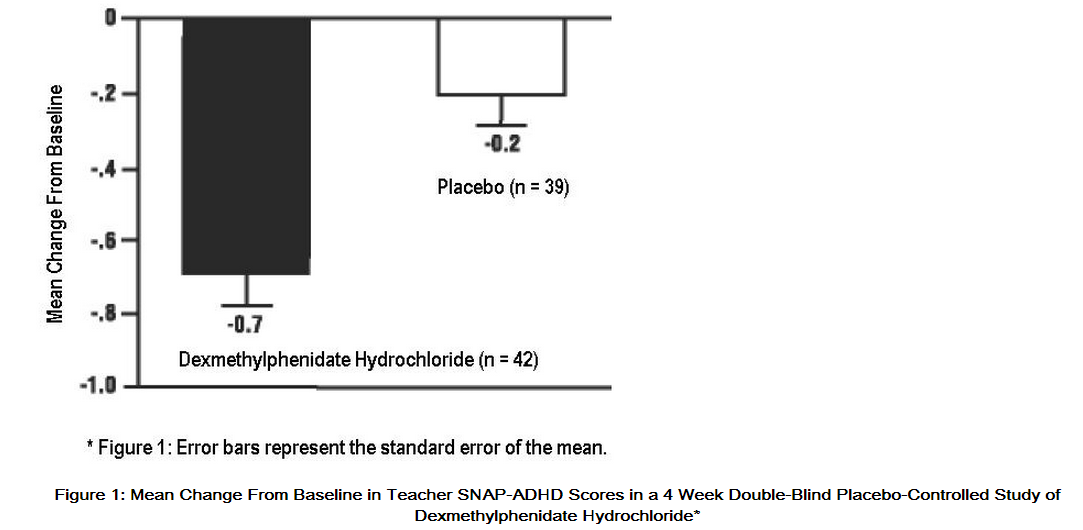
- Figure 1: Mean Change From Baseline in Teacher SNAP-ADHD Scores in a 4 Week Double-Blind Placebo-Controlled Study of Dexmethylphenidate Hydrochloride*
- The other study, involving n = 75 patients, was a multicenter, placebo-controlled, double-blind, 2 week treatment withdrawal study in children who were responders during a 6 week, open label initial treatment period. Children took study medication twice a day separated by a 3.5 to 5.5 hour interval. The primary outcome was proportion of treatment failures at the end of the 2 week withdrawal phase, where treatment failure was defined as a rating of 6 (much worse) or 7 (very much worse) on the Investigator Clinical Global Impression - Improvement (CGI-I). Patients continued on dexmethylphenidate hydrochloride showed a statistically significant lower rate of failure over patients who received placebo.
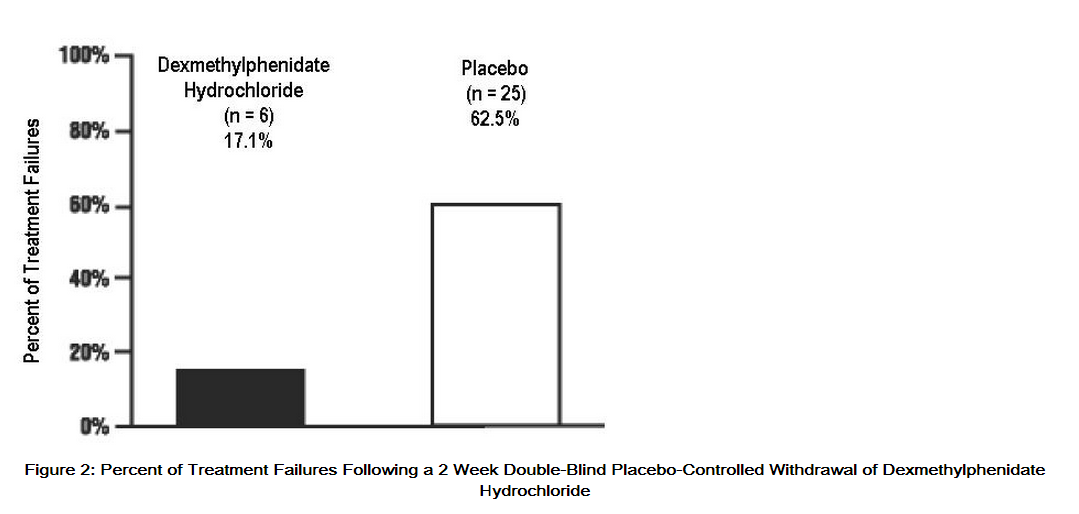
How Supplied
- Dexmethylphenidate hydrochloride tablets, 2.5 mg are blue, round-shaped, convex tablets debossed with “93” on one side and “5275” on the other side, available in bottles of 100.
- Dexmethylphenidate hydrochloride tablets, 5 mg are yellow, round-shaped, convex tablets debossed with “93” on one side and “5276” on the other side, available in bottles of 100.
- Dexmethylphenidate hydrochloride tablets, 10 mg are white to off-white, round-shaped, convex tablets, debossed with “93” on one side and “5277” on the other side, available in bottles of 100.
Storage
- Store at 20° to 25°C (68° to 77°F) [See USP Controlled Room Temperature]. Protect from light and moisture.
- Dispense in a tight, light-resistant container as defined in the USP, with a child-resistant closure (as required).
Images
Drug Images
{{#ask: Page Name::Dexmethylphenidate |?Pill Name |?Drug Name |?Pill Ingred |?Pill Imprint |?Pill Dosage |?Pill Color |?Pill Shape |?Pill Size (mm) |?Pill Scoring |?NDC |?Drug Author |format=template |template=DrugPageImages |mainlabel=- |sort=Pill Name }}
Package and Label Display Panel
{{#ask: Label Page::Dexmethylphenidate |?Label Name |format=template |template=DrugLabelImages |mainlabel=- |sort=Label Page }}
Patient Counseling Information
- Prescribers or other health professionals should inform patients, their families, and their caregivers about the benefits and risks associated with treatment with dexmethylphenidate and should counsel them in its appropriate use. A patient Medication Guide is available for dexmethylphenidate hydrochloride tablets. The prescriber or health professional should instruct patients, their families, and their caregivers to read the Medication Guide and should assist them in understanding its contents. Patients should be given the opportunity to discuss the contents of the Medication Guide and to obtain answers to any questions they may have. The complete text of the Medication Guide is reprinted at the end of this document.
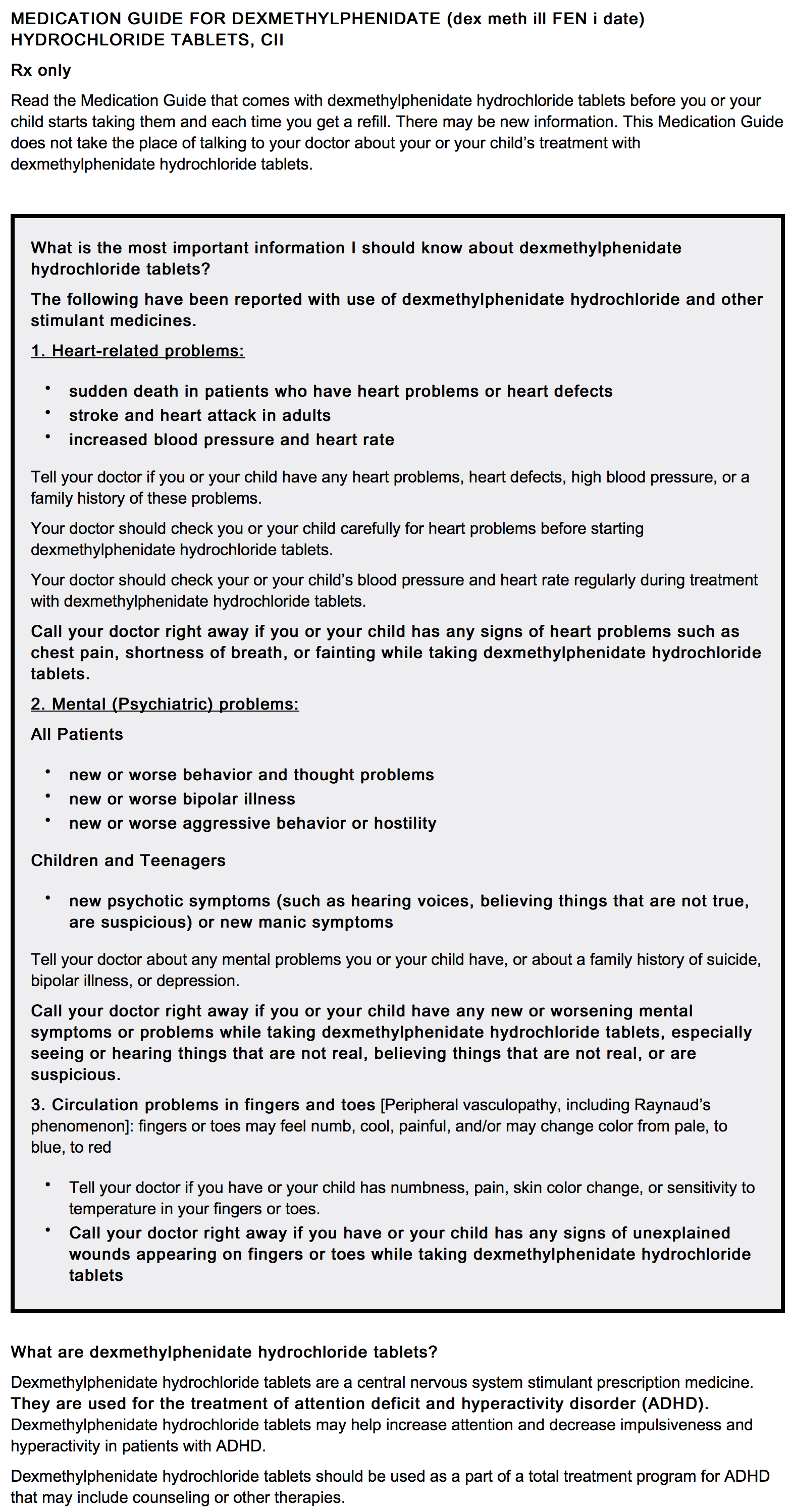
Precautions with Alcohol
- Dexmethylphenidate hydrochloride tablets should be given cautiously to patients with a history of alcoholism.
Brand Names
- ®[1]
Look-Alike Drug Names
- A® — B®[2]
Drug Shortage Status
Price
References
The contents of this FDA label are provided by the National Library of Medicine.
- ↑ Empty citation (help)
- ↑ "http://www.ismp.org". External link in
|title=(help)
{{#subobject:
|Page Name=Dexmethylphenidate
|Pill Name=No image.jpg
|Drug Name=
|Pill Ingred=|+sep=;
|Pill Imprint=
|Pill Dosage={{{dosageValue}}} {{{dosageUnit}}}
|Pill Color=|+sep=;
|Pill Shape=
|Pill Size (mm)=
|Pill Scoring=
|Pill Image=
|Drug Author=
|NDC=
}}
{{#subobject:
|Label Page=Dexmethylphenidate |Label Name=Dexmethylphenidate11.png
}}
{{#subobject:
|Label Page=Dexmethylphenidate |Label Name=Dexmethylphenidate11.png
}}